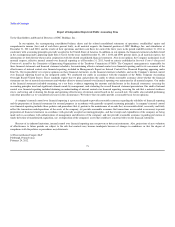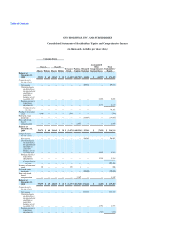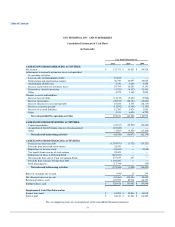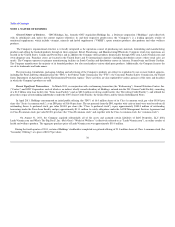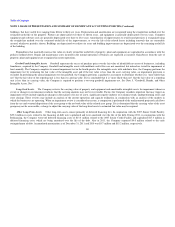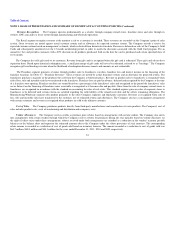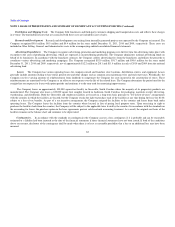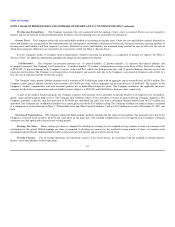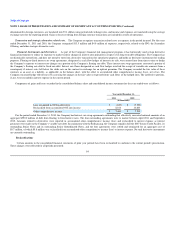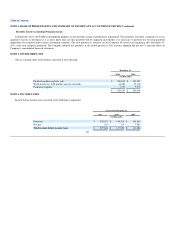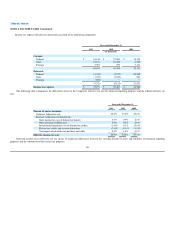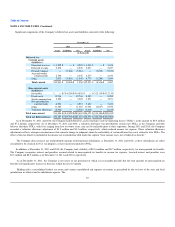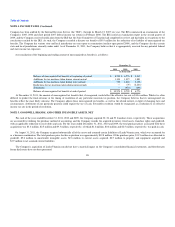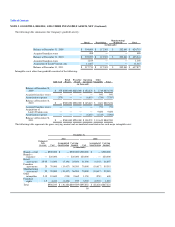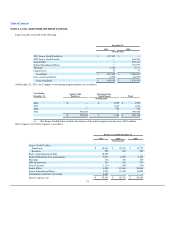GNC 2012 Annual Report Download - page 86
Download and view the complete annual report
Please find page 86 of the 2012 GNC annual report below. You can navigate through the pages in the report by either clicking on the pages listed below, or by using the keyword search tool below to find specific information within the annual report.
Table of Contents
NOTE 2. BASIS OF PRESENTATION AND SUMMARY OF SIGNIFICANT ACCOUNTING POLICIES (Continued)
Revenue Recognition. The Company operates predominantly as a retailer, through company-owned stores, franchise stores and sales through its
website, GNC.com and to a lesser extent through manufacturing and wholesale operations.
The Retail segment recognizes revenue at the moment a sale to a customer is recorded. These revenues are recorded via the Company's point of sales
system. Gross revenues are netted against actual customer returns and an allowance for expected customer returns. The Company records a reserve for
expected customer returns based on management's estimate, which is derived from historical return data. Revenue is deferred on sales of the Company's Gold
Cards and subsequently amortized over the 12 month membership period, in order to match the discounts associated with the Gold Card program. For an
annual fee, the card provides customers with a 20% discount on all products purchased, both on the date the card is purchased and certain specified days of
every month.
The Company also sells gift cards to its customers. Revenue from gift cards is recognized when the gift card is redeemed. These gift cards do not have
expiration dates. Based upon historical redemption rates, a small percentage of gift cards will never be redeemed, referred to as "breakage." The Company
recognizes gift card breakage revenue when the likelihood of redemption becomes remote and amounts are not escheatable.
The Franchise segment generates revenues through product sales to franchisees, royalties, franchise fees and interest income on the financing of the
franchise locations. See Note 17, "Franchise Revenue." These revenues are netted by actual franchisee returns and an allowance for projected returns. The
franchisees purchase a majority of the products they sell from the Company at wholesale prices. Revenue on product sales to franchisees is recognized when
risk of loss, title and insurable risks have transferred to the franchisee. Franchise fees are paid in advance, deferred and recognized by the Company at the time
of a franchise store opening. Franchise royalties are earned based on a percentage of the franchisees' sales and recognized in the period the franchisees' sales
occur. Interest on the financing of franchisee notes receivable is recognized as it becomes due and payable. Gains from the sale of company-owned stores to
franchisees are recognized in accordance with the standard on accounting for sales of real estate. This standard requires gains on sales of corporate stores to
franchisees to be deferred until certain criteria are satisfied regarding the collectability of the related receivable and the seller's remaining obligations. The
Manufacturing/Wholesale segment sells product primarily to the other Company segments and third-party customers. Revenue is recognized when risk of
loss, title and insurable risks have transferred to the customer, net of estimated returns and allowances. The Company also has a consignment arrangement
with certain customers and revenue is recognized when products are sold to the ultimate customer.
Cost of Sales. The Company purchases products directly from third-party manufacturers and manufactures its own products. The Company's cost of
sales includes product costs, costs of warehousing and distribution and occupancy costs.
Vendor Allowances. The Company receives credits as purchase price rebates based on arrangements with certain vendors. The Company also enters
into arrangements with certain vendors through which the Company receives rebates for purchases during the year typically based on volume discounts. As
the right of offset exists under these arrangements, rebates received under both arrangements are recorded as a reduction in the vendors' accounts payable
balances on the balance sheet and represent the estimated amounts due to the Company under the rebate provisions of such contracts. The corresponding
rebate income is recorded as a reduction of cost of goods sold based on inventory turnover. The amount recorded as a reduction to cost of goods sold was
$64.7 million, $40.0 million and $34.1 million for the years ended December 31, 2011, 2010 and 2009, respectively.
81


